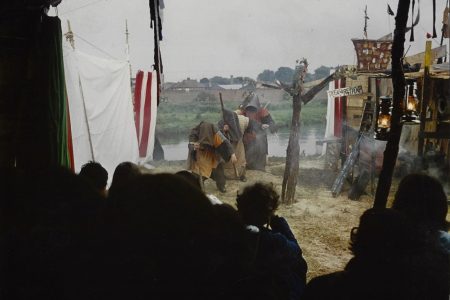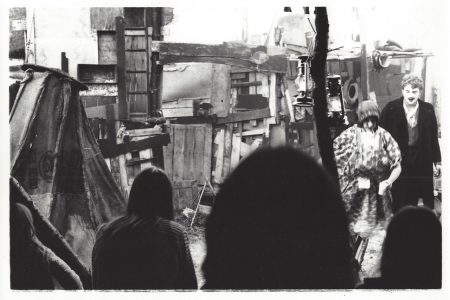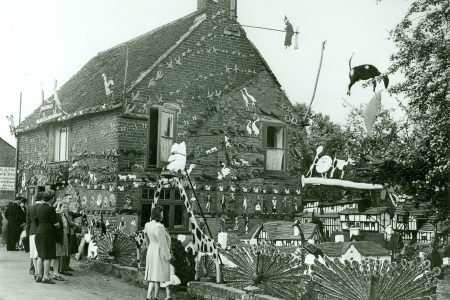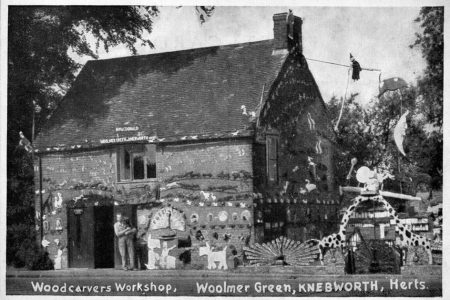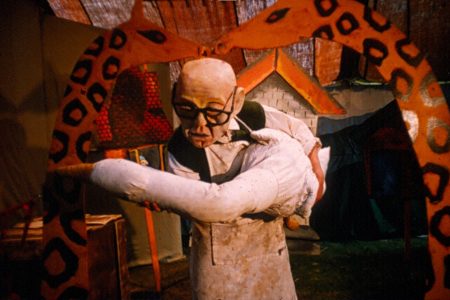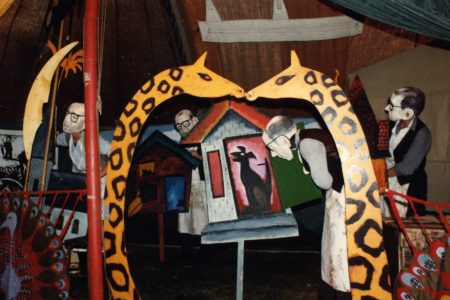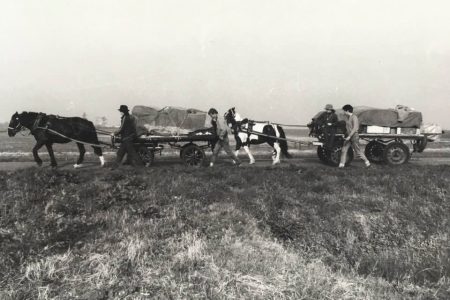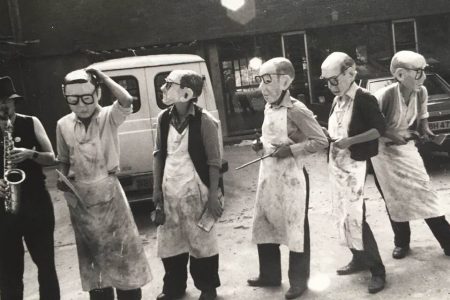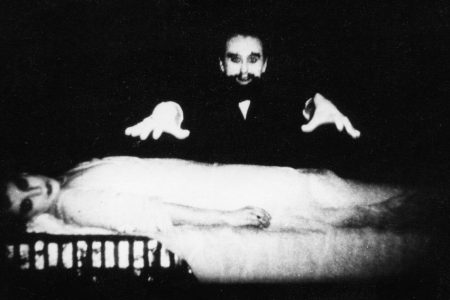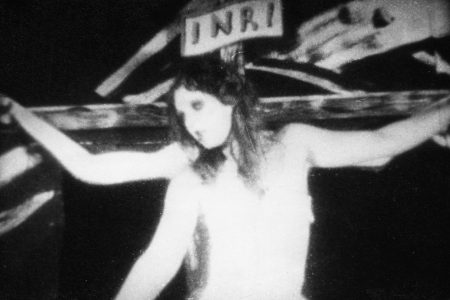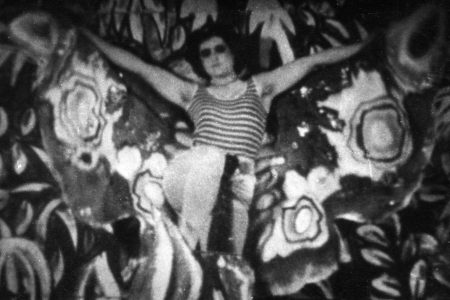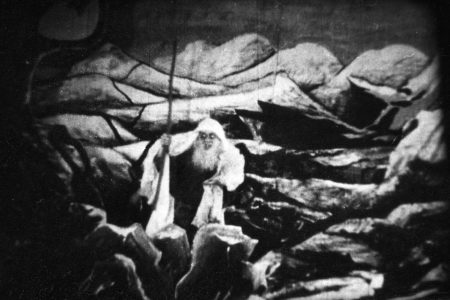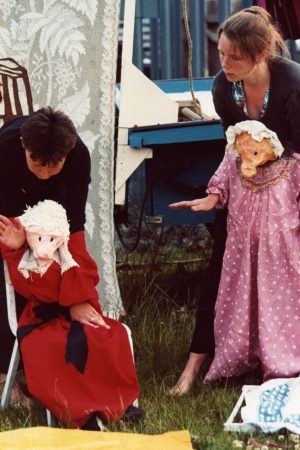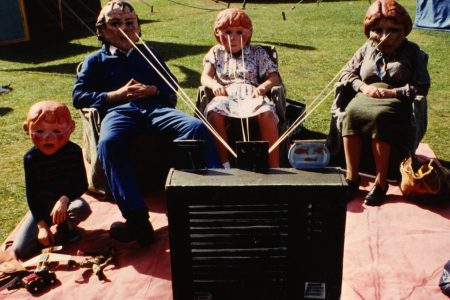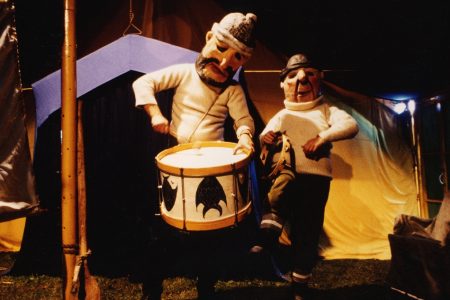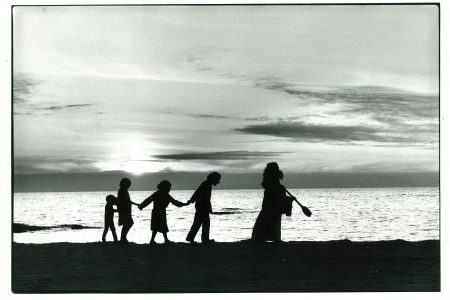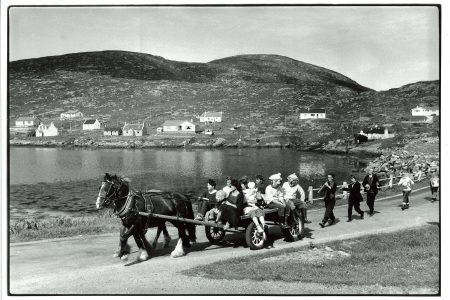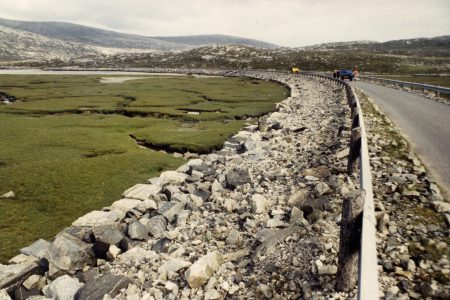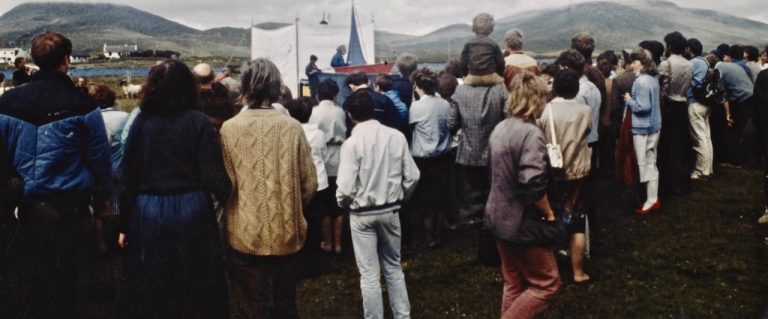By 1981 we had a workshop big enough for up to a dozen people to live in. Admittedly it was all rather rough and ready, with an outdoor self-built chemical loo, no hot water, and just one woodburning stove. Most of the company slept on the shelves that we had built to hold materials – fabric, wood etc. Although the spirit of the group was good, it was dawning on me that keeping this company going for the long haul was throwing up new and difficult challenges. To keep it going we would have to find other ways of sustaining and funding ourselves.
Little Heads
Our next show, Little Heads (Shouldn’t Wear Big Hats) reflected a lot of my uncertainties both as writer and director. The show lacked coherence, but among the good things were storytelling interludes by Edward Taylor. Edward eventually hooked up with Sue Auty, who was also touring with us at this point. Later they formed the Whalley Range All-Stars.
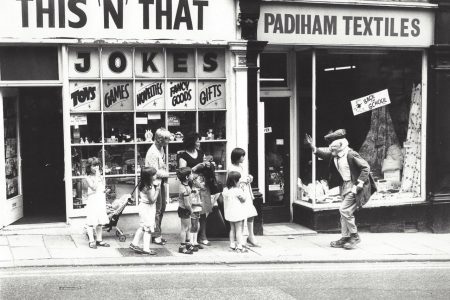 Another positive thing that happened at this time was that we began to experiment with going out onto the street and improvising performances. Sometimes it would be a group of performers together and sometimes just one (often masked) performer on their own, perhaps accompanied by a musician on saxophone or drums. Looking back at the photographs from those ad-hoc performances I feel that they might have had more going for them than the show itself. The forays onto the street were really intended to promote the main show, as the performer was usually also accompanied by someone with handouts about the event. But they turned out to be a lot more than that; helping the performers to develop their improvisation skills, and giving us the freedom to play, away from the discipline of putting an hour-long show together.
Another positive thing that happened at this time was that we began to experiment with going out onto the street and improvising performances. Sometimes it would be a group of performers together and sometimes just one (often masked) performer on their own, perhaps accompanied by a musician on saxophone or drums. Looking back at the photographs from those ad-hoc performances I feel that they might have had more going for them than the show itself. The forays onto the street were really intended to promote the main show, as the performer was usually also accompanied by someone with handouts about the event. But they turned out to be a lot more than that; helping the performers to develop their improvisation skills, and giving us the freedom to play, away from the discipline of putting an hour-long show together.
Leicester Festival
Then, out of nowhere, we were invited to take part in Leicester Festival by its director, Ted Little.I deconstructed the script of ‘Little Heads’, and then abandoned it altogether, starting again. While almost as ramshackle as the canal-side theatre structure, the new production gained a fresh strength from new folktale elements. We also incorporated images taken from Goya’s etchings, as well as a crazy vein of surreal comedy provided by Edward.
The show also had at least one genuine visual trump card. The entrances to (and exits from) the stage could be made from a large raft punted across the canal, with its own curtain. At one point Edward Taylor appeared from underwater in a submarine escape suit, dragging a box onto the stage. He opens the box and dripping wet puppets appear, which kick off a new storyline. It became one of the hits of the Festival, and by the last night it was full to overflowing. Then, after the curtain call, the cast left the stage by raft, floating away down the canal. As the audience left, the whole theatre burst into flame and was razed to the ground before their eyes. The fire was so intense from the tarry boat-wood that there was an unplanned miniature fire-storm. That evening was also memorable as three of the cast ended in A&E, as a planned but entirely unrehearsed jump from the burning three-metre high wooden wall of the set resulted in severely sprained ankles and legs. Fortunately no bones were broken.
BOB FRITH, PAUL KERSHAW, SUE AUTY, EDWARD TAYLOR, ANDREW MILNE BERESFORD, KEITH BRAY (m), PETER LINDHOUT, JAKE, FIONA FRANK, ADRIAAN KRABBENDAM, GILL PEARSON, WIN HUNT (h), KAY KENNEDY
1982: Memories of childhood
At the age of 9 my family moved to Stevenage from Stoke Newington, London. In Stevenage almost everything was new. The houses, the roads, the fences. Luckily, our street was on the very edge of the town, overlooking a water meadow. Everything else was clean, shiny and gleaming. For my mum and dad this was clearly one of its attractions. However the main reason I took to Rossendale a decade later was that it was in such a complete contrast to Stevenage. In other words nothing seemed to be at right angles to anything else.
Because we lived right on the edge of town, within two minutes I could be in the countryside. It meant that a lot of my free time was taken exploring the fields, streams, ponds and dells – all within walking distance. As I grew older I ventured further and further from home. Three miles away, in a village called Woolmer Green, I came across the house of an elderly wood-carver. Later I discovered that his name was Harry Macdonald and that he came from Bradford.
Harry had walked south down the A1 during the Depression looking for work. When he arrived at Woolmer Green he found a barn for rent. He decided to stay, selling wood-carvings to travellers along the Great North Road. He quickly realised that it would help if he created something eye-catching to stop the traffic by his workshop.
The house and garden
Over the next few years Harry covered his workshop in brightly carved figures, including a carved policeman by the side of the road holding up its hand in a ‘halt’ command. He made the barn into an extraordinary place, a kind of fairytale world. The garden was transformed into nursery-rhyme village, complete with puppet-like working parts. A cow jumped over a moon. 230 scottie dogs wearing bow-ties ran round the walls of the house. Carved giraffes and toucans looked down onto the road. A witch flew past the chimney on her broomstick. You could turn a handle and a hand-coloured elephant would blow water from its trunk.
The Woodcarver show
In 1982, after four years of Horse + Bamboo, I was looking for a subject for the next show. Harry’s story was perfect. At that time we toured with an old ex-army marquee, and the puppets and structures that re-created a version of Harry’s house and garden were fixed in the ground of the stage area with bamboo poles. As the almost life-size puppet bulldozer moved through the tent all of these were pushed flat and the grass and earth stage area was left as a scene of devastation.
One notable thing about the tour was that we walked, with our horses and carts, the 200 or so miles from Scunthorpe to Woolmer Green. We stopped at various points to do pre-planned shows en route, including at Alford and Digswell House in Welwyn. But the final shows were held in Woolmer Green itself, and our marquee was pitched just a hundred yards from Harry Macdonald’s old house. The realisation that the whole tour had become a sort of pilgrimage slowly dawned on me as our convoy of horses, carts and people slowly moved south towards the Woodcarver’s Cottage.
A final performance
At the end of the very last show a drummer (me) and the other musicians led the performers, followed by the audience, out of the field. We turned left along the old Great North Road right past Harry’s house, and then left again into the village churchyard. Here we made our way to Harry Macdonald’s graveside. We stopped by the grave and lit candles; we placed tiny puppet versions of his house and carvings on the tombstone. Our band played one last tune, and a stilt-dancer moved among the grave stones in the cemetery. Then it was over.
When we were leaving the next day, meeting up with out horse-transport to take everything back to Lancashire, I met a few of the villagers to thank them for their support. They presented me with a wooden head of a dog, beautifully carved by Harry, as a memento of our visit to Woolmer Green with our show. It’s still hanging in my living room, and I decorate it every Christmas.
A step forward
In retrospect, The Woodcarver Story represented a big advance in the company’s theatre work. Before it, our shows had combined puppets, objects, music and masks in a loose, surreal and episodic mixture. In large part this was influenced by my work at Welfare State. Mixed into this were some formal elements influenced by what I knew of Bread and Puppet’s work in the US. By contrast The Woodcarver Story developed a fresh approach. Masked characters combined with puppetry to tell a largely linear story with a tightly scripted narrative. It was the first Horse + Bamboo show to do this, and the first show in which the company’s distinctive style emerged. For me it was the show when I began to feel happy in the role of artistic director.
The living sculptures of masks and the painted images of the setting reveal a strong link with the tradition of expressionist art that runs from the medieval drawings of Grunewald to this century’s glowing colours of Georges Rouault. Among the stylistic influences is an eloquent simple style carrying a greater emotional impact than could be achieved through naturalism. The grasp of traditional art forms is such that the incorporation of of a time based element becomes essential to sustain the concern for story that is at the heart of H&B’s work.
Phil Hyde, Performance magazine. Dec/Jan 1983.
BOB FRITH, PAUL KERSHAW, JAY VENN (h), MALA SIKKA, AMANDA SPEED, BARBARA NICHOLLS, MELISSA WYER, SUE GOODWIN, KEITH BRAY (m), DAVE GILES (m), KAY KENNEDY (maker), BRIAN KNOX (support)
1983: Needles In a Candleflame
The success of The Woodcarver Story tour gave us a new confidence and North West Arts and the Arts Council increased our support grant. The extra funding meant that we could tour with a cast of 9, including three musicians. Selling the ‘Needles In A Candleflame’ tour had been more successful too; we organised a tour that started in Hebden Bridge, then travelled by truck and horsebox to Scotland, where we toured Dunfermline, Pittenweem, St Andrews, and Kirkaldy. Then south into North-East England and Alnwick, Alnmouth, Amble, Acklington, Ashington, Gateshead, Jarrow, Biddick, Cleveland, Yarm, and ending at Darlington Arts Centre.
The show was based very loosely on the story ‘On Discovery’ from Maxine Hong Kingston’s novel ‘China Men’. It’s the story of a shipwrecked sailor, who finds himself washed up on the shore of the Land of Women. At first, rescued by the inhabitants, he thinks he has fallen on his feet. As he undergoes the routines, restraints, habits and tortures (foot-binding, hair plucking etc) that the women endure, he realises that he is slowly and painfully being transformed into a woman himself, and that it’s no joke.
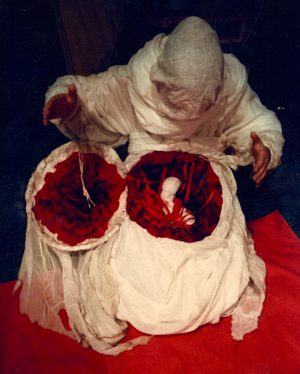
16mm film
We began the show with a 15 minute film, made in a 16mm black-and-white period style. This demonstrated the ‘enchanting fantasies’ acted out by Victorian magicians on their female assistants. To do this we spent weeks in our workshop painstakingly recreating many of the tricks from the early cinema. Doing this we came across the magician, showman and pioneering film-maker Georges Melies. We used an old Bolex camera and black and white film stock, sending off each days’ rushes and receiving them back from the lab early the next morning.
After this the curtain fell inside the marquee to open up the theatre space. The image of the Butterfly Woman gave way to the story of a butterfly hunter who is ‘captured’ by a small group of women. We follow his travails in yet another Land of Women. Finally, once the audience have vacated the marquee, there was a short outdoor puppet show. This was based on a Moomintroll story,’The Fillyjonk Who Believed in Disasters’. In 2007 we radically re-worked this into Storm in a Teacup.
Pittenweem Festival
We were able to promote this edgy and feminist production as a ‘family show’, something I don’t think would be possible today. At the first show at the Festival at Pittenweem, a member of the audience stood up and announced that it was ‘disgusting’. Ironically, given the story, he ordered his wife to leave with him. He then asked the audience to join him in walking out in a mass protest. Nobody moved, but he nevertheless reported us to the police. The police in turn asked Joyce Laing, the Festival Director (and the Art Therapist at Barlinnie prison) to check out the show. As she hadn’t yet seen it, Joyce came to the very next performance, and we then waited for her verdict. Which was, ‘nay problem’.
For the last night of Pittenweem Arts Festival we improvised a raft with a fire sculpture built onto it. The idea was for it to be lit, then floated out to sea from the harbour after the Carnival Parade – the finale of the week-long festival. Unfortunately that night was unusually still and the sea untypical calm, and the raft refused to leave with the tide. Not wanting to disappoint the crowd of spectators Melissa Wyer, one of our performers, stripped down to her underwear, jumped into the harbour and towed the raft out to sea, swimming with the tow rope gripped in her mouth.
BOB FRITH, KEITH BRAY (m), DAVE GILES (m), MELISSA WYER, ADAM STRICKSON, MOIRA HIRST (h), RONA LEE, LUANA DEE, CLAIRE HEWLETT, AMANDA SPEED (admin)
1984: SEOL
The 1983 tour of Fife had happened in large part because of the help and support of Jenny Wilson, Director of the Crawford Arts Centre in St Andrews. Jenny had previously been Director at Mid-Pennine Arts, and one of our earliest supporters. Later Jenny went on to become Director of Dumfries and Galloway Arts Association. After recommendations from Jenny we were approached by the Scottish Arts Council to consider a tour of the Outer Hebrides. So, in October 1983, I went off for a preliminary reconnaissance to see if this attractive possibility would be viable. I began my journey at the southern islands, taking the Calmac ferry from Oban to Barra.
After Barra I made my way north, from Eriskay through the Uists and Benbecula, to Berneray and then to Harris. As I went north I moved further away from Catholicism, and by the time I was in North Uist it was clearly a protestant country, a place of the Free Church, the ‘Wee Frees’. Early in 1983, with the outline of the tour agreed, I returned with Moira Hirst, our horse-handler, and we plotted out a more precise itinerary for the tour, heading north again, from Vatersay and Barra. In the event we decided against Lewis as the long pull north on the A589 from Harris was daunting and probably not doable by our horses given the heavy loads they pulled. So our tour had to finish further south, in Tarbert, the ‘capital’ of Harris, and nearby Seilobost.
The show
We read and learned from the experiences of other companies who had made shorter tours of the islands. One result of this was that a friend (Sue MacGovern) went on an advance cycle tour of the route. Sue spoke to locals and put up posters two weeks before our arrival. I wrote a script based around local themes. A story of a voyage undertaken by a young girl in search of her father and younger brother who had been taken in a storm whilst out fishing. Being wordless it avoided the English versus Gaelic issue, and I was able to weave in a storyline relating to a very topical concern on the islands – the radioactive spill from English nuclear plants such as Windscale, which local fisherman feared threatened the fish stocks.
‘Seòl‘ (pronounced ‘shawl’) in Gaelic means as a noun ‘sail’, as a verb ‘sail, guide or navigate’. I chose it as the title of the production. In Barra we camped at Tangasdale, a beautiful site near to the friendly Isle of Barra hotel. We also received an invitation to participate in Fèis Bharraigh (Barra Fèis), which opened the next day. The weather was wonderful. Our large parade puppets, including a Kelpie, or Water Horse, led the procession, followed by our band and performers in masks and costumes. Then three trucks carrying local children playing a variety of instruments. That evening we were invited to the local ceilidh in Castlebay, and we joined in with the locals, enjoying the traditional dances until the early hours of the morning. We were told that we made it seem “like New Orleans (had) come to Barra”.
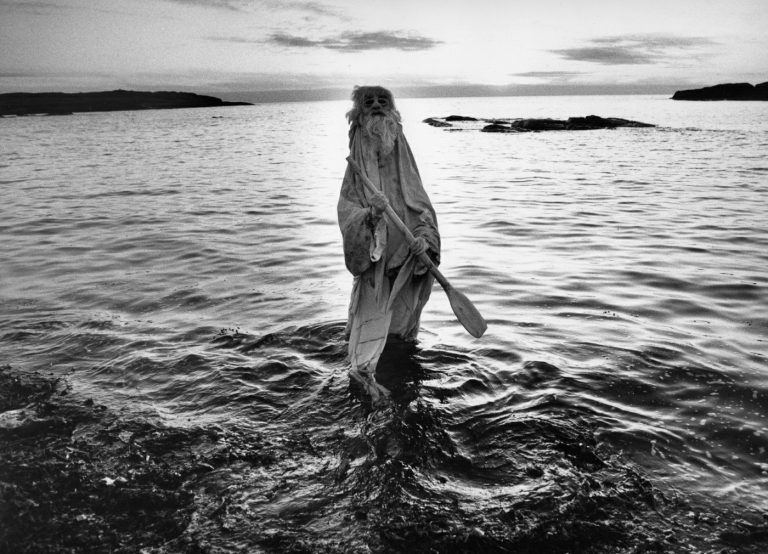
The tour
The tour was memorable to say the least. Two months travelling to 9 islands. Adventures came almost daily. ‘The Guardian’ flew out arts reporter Robin Thornber and photographer Dennis Thorpe (who took the 3 black & white photographs on this page). They stayed with us on Barra for a couple of days, joining in with our lives and reviewing and photographing our work. In the end they felt that Dennis’s photographs were so good that they published a full page photo-feature about the tour.
Leaving Barra we travelled to Lochboisdale where we were treated to a spontaneous ceilidh around the campfire – songs, dancing and stories. Then on through South Uist to Eochar (Iochdar) where Angus McPhee had lived. I only got to know about Angus many years later. Then to Carinish, and through North Uist to Lochmaddy and the island of Berneray. On Berneray we arrived on the same day as the Annual Peat Procession and Auction. Like Vatersay there’s now a causeway to Berneray but then it also meant a sea journey. Getting the horses onto the deck of a small ferry was now a little easier – we lured them on with carrots. Once there we helped revive the old tradition of using horses and carts to deliver the peat to the crofts dotted around the island. The peat came from the uninhabited island of Torogay, and was loaded onto carts and distributed throughout Berneray. This also ended with a great ceildih, with our masks and still figure, and a display of Highland dancing. It went on into the early hours.
Everywhere that summer the travel days took us through stunning scenery; at every stop we had enthusiastic audiences. The show was well received and one of the most memorable experiences in the company’s history. It then went on to a short tour of the north-west of England. This turned out to be the last tour for two years as we spent the summer of 1985 moving into new premises.
BOB FRITH, MICK WILSON (m), SALLY MARTIN (admin), MERIGAN MARTIN, MOIRA HIRST (h), ADAM STRICKSON, MELISSA WYER, ALAN KENNEDY (m), KATHY STRACHAN, BERNARD TINDALL.
